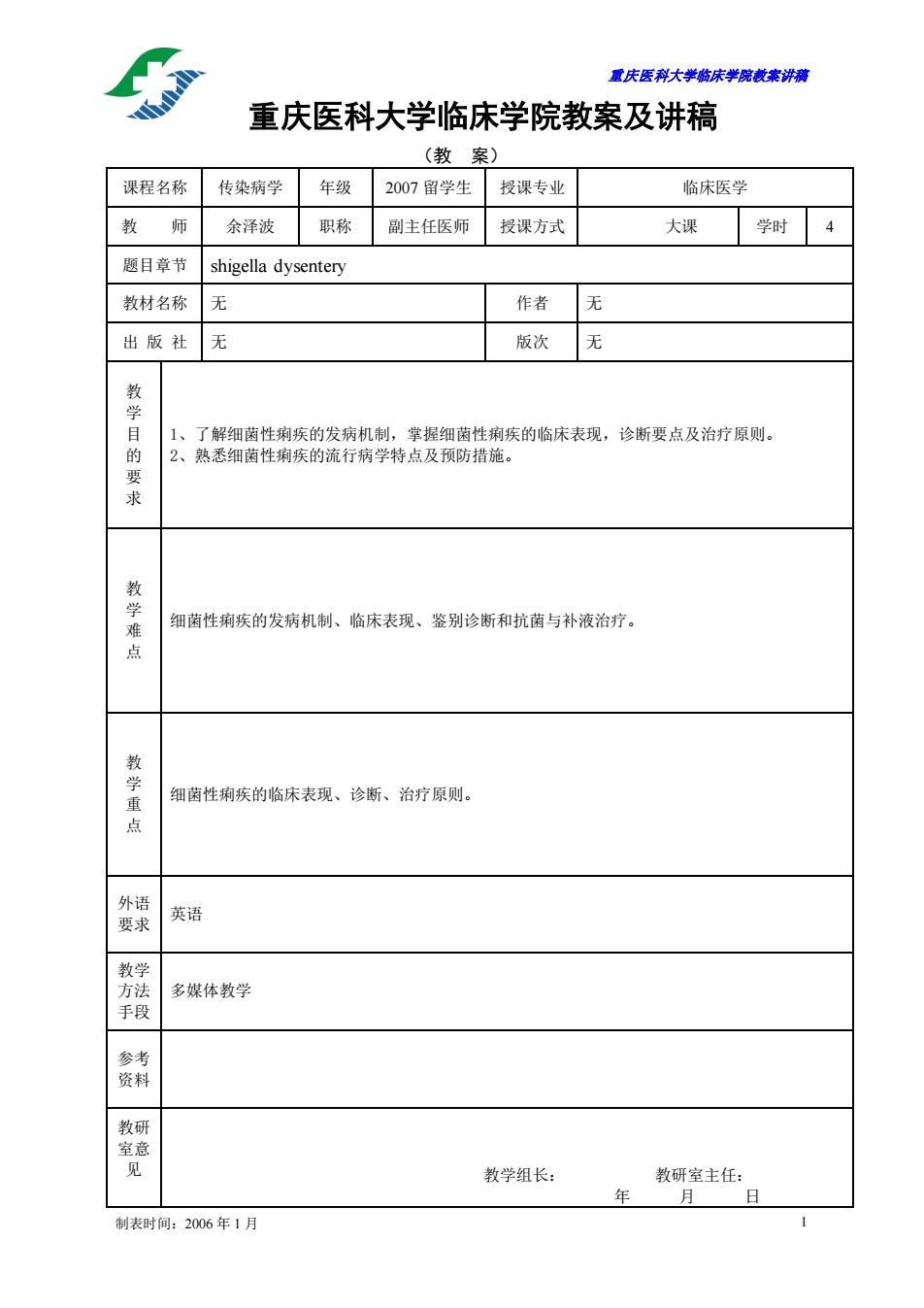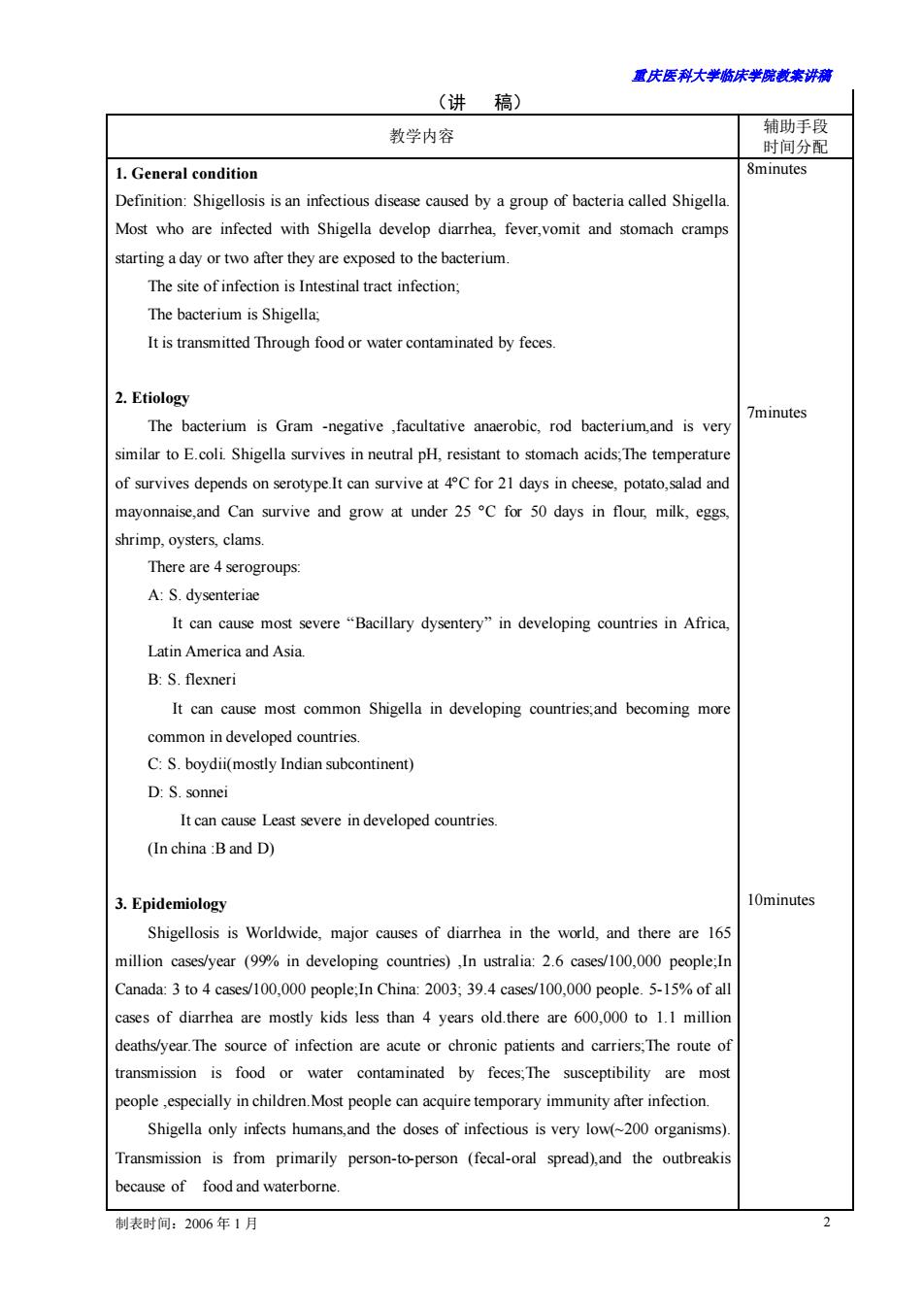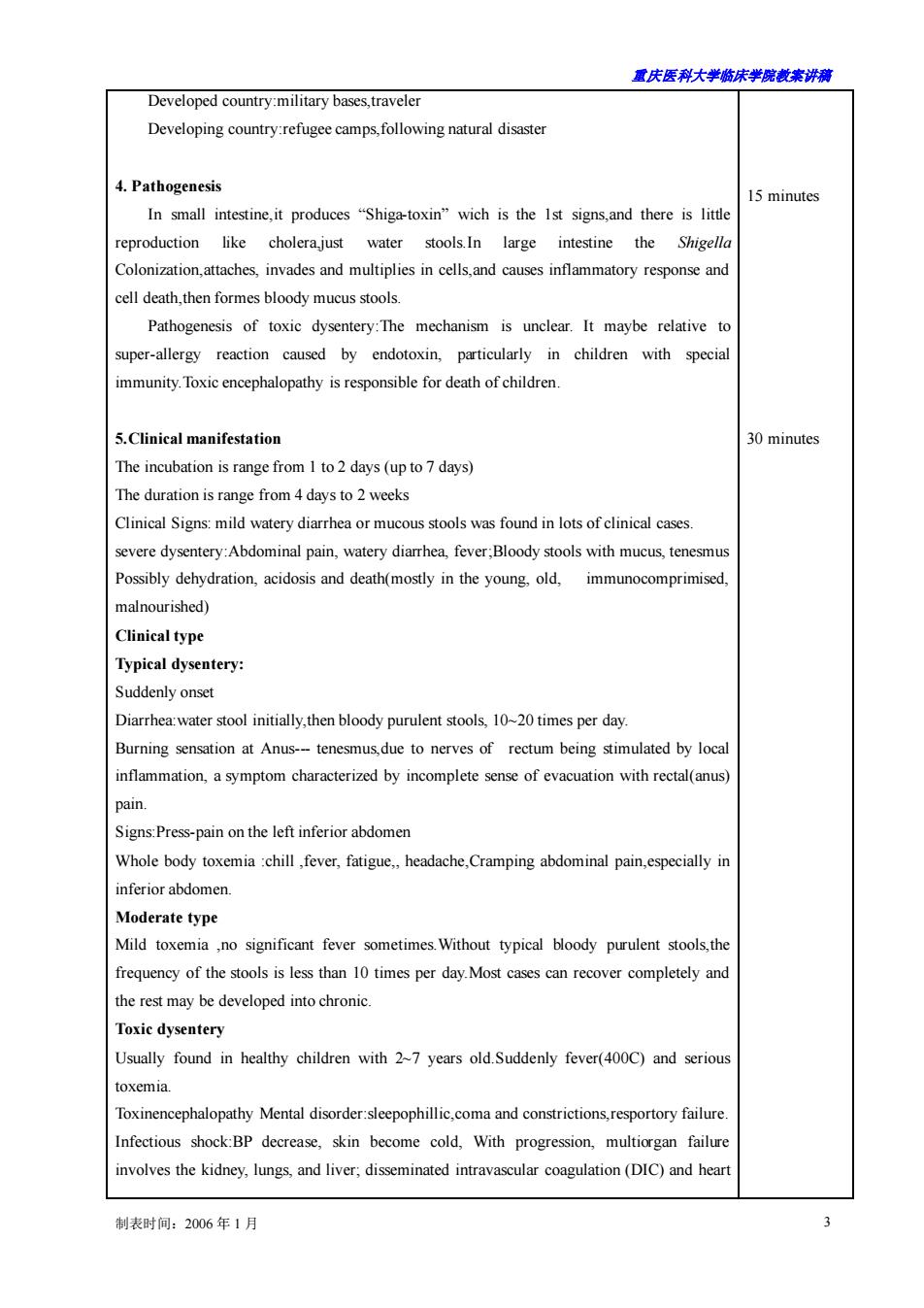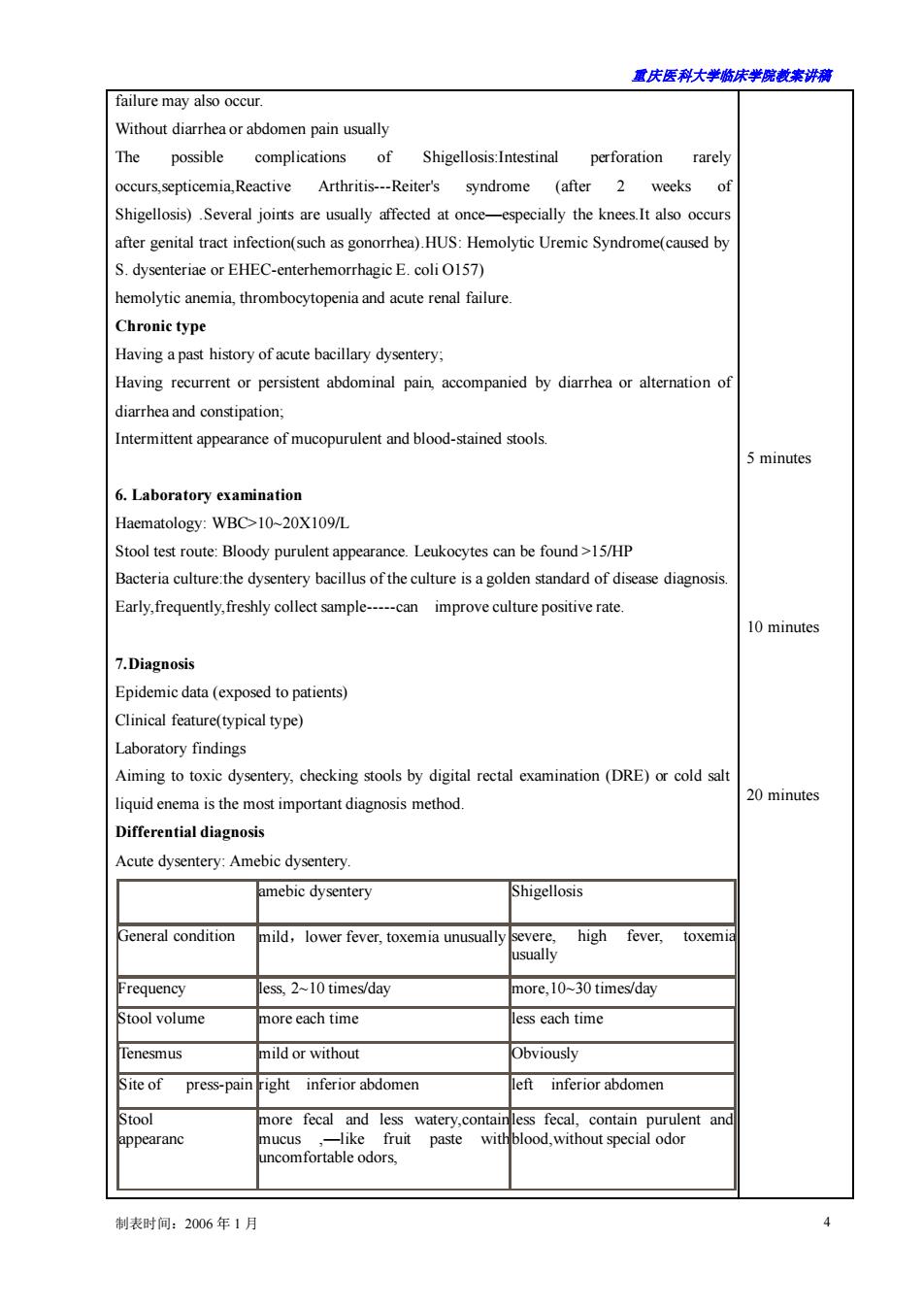
置庆医科大学脑床学院裁来讲满 重庆医科大学临床学院教案及讲稿 (教案) 课程名称传染病学年级2007留学生授课专业 临床医学 教师余泽波职称剧主任医师授课方式 大课学时4 题目章节shigella dysentery 教材名称无 作者无 出版社无 版次无 整 1、了解细菌性痢疾的发病机制,掌握细菌性痢疾的临床表现,诊断要点及治疗原则。 2、熟悉细菌性掬疾的流行病学特点及预防措施。 学难点 细菌性掬疾的发病机制、临床表现、鉴别诊断和抗菌与补液治疗。 教学重点 细菌性痢疾的临床表现、诊断、治疗原则。 外语 要求 英语 多媒体教学 手段 资青 见 教学组长: 教研室主任: 年 月日 制表时间:2006年1月 1
重庆医科大学临床学院教案讲稿 制表时间:2006 年 1 月 1 重庆医科大学临床学院教案及讲稿 (教 案) 课程名称 传染病学 年级 2007 留学生 授课专业 临床医学 教 师 余泽波 职称 副主任医师 授课方式 大课 学时 4 题目章节 shigella dysentery 教材名称 无 作者 无 出 版 社 无 版次 无 教 学 目 的 要 求 1、了解细菌性痢疾的发病机制,掌握细菌性痢疾的临床表现,诊断要点及治疗原则。 2、熟悉细菌性痢疾的流行病学特点及预防措施。 教 学 难 点 细菌性痢疾的发病机制、临床表现、鉴别诊断和抗菌与补液治疗。 教 学 重 点 细菌性痢疾的临床表现、诊断、治疗原则。 外语 要求 英语 教学 方法 手段 多媒体教学 参考 资料 教研 室意 见 教学组长: 教研室主任: 年 月 日

置庆医科大学床半院未讲满 (讲稿) 教学内容 铺助手段 时间分配 1.General condition 8minutes Definition:Shigellosis is an infectious disease caused by a group of bacteria called Shigella Most who are infected with Shigella develop diarrhea,fever,vomit and stomach cramp starting a day or two after they are exposed to the bacterium. The site of infection is Intestinal tract infection, The bacterium is Shigella It is transmitted Through food or water contaminated by feces. 2.Etiology 7minutes The bacterium is Gram-negative,facultative anaerobic.rod bacteriumand is very similar to E.coli.Shigella survives in neutral pH,resistant to stomach acids,The temperature mayonnaise,and Can survive and grow at under 25 C for 50 days in flour,milk,eggs hrimp,oysters,clams. There are 4 serogroups: A:S.dysenteriae It can cause most severe"Bacillary dysentery"in developing countries in Africa, Latin America and Asia B:S.flexneri It can cause most common Shigella in developing countries and becoming more common in developed countries. C.S.boydii(mostly Indian subcontinent) D:S.sonnei It can cause Least severe in developed countries. (In china:B and D) 3.Epidemiology 10minutes Shigellosis is Worldwide,major causes of diarrhea in the world,and there are 165 milion cases/year (in developing countries)ustralia:6cases/people:I Canada:3 to 4 cases/100,000 people,In China:2003:9.4 cases/100,000 people.5-15%of all ases of diarrhea are mostly kids less than 4 years old there are 600.000 to 1.1 millio deaths/year.The source of infection are acute or chronic patients and carriers;The route of transmission is food or water contaminated by feces.The susceptibility are mos peopleespecially in children.Most people can acquire temporary immunity after infection. Shigella only infects humans,and the doses of infectious is very low(200 organisms) Transmission is from primarily person-to-person (fecal-oral spread).and the outbreakis because of food and waterborne. 制表时间:2006年1月
重庆医科大学临床学院教案讲稿 制表时间:2006 年 1 月 2 (讲 稿) 教学内容 辅助手段 时间分配 1. General condition Definition: Shigellosis is an infectious disease caused by a group of bacteria called Shigella. Most who are infected with Shigella develop diarrhea, fever,vomit and stomach cramps starting a day or two after they are exposed to the bacterium. The site of infection is Intestinal tract infection; The bacterium is Shigella; It is transmitted Through food or water contaminated by feces. 2. Etiology The bacterium is Gram -negative ,facultative anaerobic, rod bacterium,and is very similar to E.coli. Shigella survives in neutral pH, resistant to stomach acids;The temperature of survives depends on serotype.It can survive at 4°C for 21 days in cheese, potato,salad and mayonnaise,and Can survive and grow at under 25 °C for 50 days in flour, milk, eggs, shrimp, oysters, clams. There are 4 serogroups: A: S. dysenteriae It can cause most severe “Bacillary dysentery” in developing countries in Africa, Latin America and Asia. B: S. flexneri It can cause most common Shigella in developing countries;and becoming more common in developed countries. C: S. boydii(mostly Indian subcontinent) D: S. sonnei It can cause Least severe in developed countries. (In china :B and D) 3. Epidemiology Shigellosis is Worldwide, major causes of diarrhea in the world, and there are 165 million cases/year (99% in developing countries) ,In ustralia: 2.6 cases/100,000 people;In Canada: 3 to 4 cases/100,000 people;In China: 2003; 39.4 cases/100,000 people. 5-15% of all cases of diarrhea are mostly kids less than 4 years old.there are 600,000 to 1.1 million deaths/year.The source of infection are acute or chronic patients and carriers;The route of transmission is food or water contaminated by feces;The susceptibility are most people ,especially in children.Most people can acquire temporary immunity after infection. Shigella only infects humans,and the doses of infectious is very low(~200 organisms). Transmission is from primarily person-to-person (fecal-oral spread),and the outbreakis because of food and waterborne. 8minutes 7minutes 10minutes

君庆医科大学临床半院表来讲满 Developed country:military bases,traveler Developing country:refugee camps,following natural disaster 4.Pathogenesis 15 minutes In small intestine.it produces"Shiga-toxin"wich is the Ist signs,and there is little reproduction like cholera.just water stools.In large intestine the Shigell Colonization,attaches,invades and multiplies in cells,and causes inflammatory response and cell death,then formes bloody mucus stools. Pathogenesis of toxic dysentery:The mechanism is unclear.It maybe relative to super-allergy reaction caused by endotoxin,particularly in children with special mmunityToxic encephalopathy is responsible for death of children. 5.Clinical manifestation 0minutes The incubation is range from I to2 days(up to7 days) The duration is range from4 days to2 weeks Clinical Signs:mild watery diarrhea or mucous stools was found in lots of clinical cases. severe dysentery:Abdominal pain,watery diarrhea,fever Bloody stools with mucus,tenesmus Possibly dehydration,acidosis and death(mostly in the young.old,immunocomprimised. Clinical type Typical dysentery: Suddenly onset Diarrhea water stool initially,then bloody purulent stools,10~20 times per day. Burning at Anus-tenesmus due to nerves of rectum being stimulated by loc inflammation,a symptom characterized by incomplete sense of evacuation with rectal(anus) ain. Signs:Press-pain on the left inferior abdomen Whole body toxemiachill,fever,fatigue.headache.Cramping abdominal pain.especially in nferior abdomen. Moderate type Mild toxemia,no significant fever sometimes.Without typical bloody purulent stools,the frequeny of the stools is less than 10 times per day.Most casescan recover completely and the rest may be developed into chronic. Toxic dysentery Usually found in healthy children with 2~7years old.Suddenly fever(400C)and seriou oxemia. Toxinencephalopathy Mental Infectious shock:BP decrease,skin become cold,With progression,multiorgan failure nvolves the kidney.lungs,and (DIC)and heart 制表时间:2006年1月
重庆医科大学临床学院教案讲稿 制表时间:2006 年 1 月 3 Developed country:military bases,traveler Developing country:refugee camps,following natural disaster 4. Pathogenesis In small intestine,it produces “Shiga-toxin” wich is the 1st signs,and there is little reproduction like cholera,just water stools.In large intestine the Shigella Colonization,attaches, invades and multiplies in cells,and causes inflammatory response and cell death,then formes bloody mucus stools. Pathogenesis of toxic dysentery:The mechanism is unclear. It maybe relative to super-allergy reaction caused by endotoxin, particularly in children with special immunity.Toxic encephalopathy is responsible for death of children. 5.Clinical manifestation The incubation is range from 1 to 2 days (up to 7 days) The duration is range from 4 days to 2 weeks Clinical Signs: mild watery diarrhea or mucous stools was found in lots of clinical cases. severe dysentery:Abdominal pain, watery diarrhea, fever;Bloody stools with mucus, tenesmus Possibly dehydration, acidosis and death(mostly in the young, old, immunocomprimised, malnourished) Clinical type Typical dysentery: Suddenly onset Diarrhea:water stool initially,then bloody purulent stools, 10~20 times per day. Burning sensation at Anus- tenesmus,due to nerves of rectum being stimulated by local inflammation, a symptom characterized by incomplete sense of evacuation with rectal(anus) pain. Signs:Press-pain on the left inferior abdomen Whole body toxemia :chill ,fever, fatigue, headache,Cramping abdominal pain,especially in inferior abdomen. Moderate type Mild toxemia ,no significant fever sometimes.Without typical bloody purulent stools,the frequency of the stools is less than 10 times per day.Most cases can recover completely and the rest may be developed into chronic. Toxic dysentery Usually found in healthy children with 2~7 years old.Suddenly fever(400C) and serious toxemia. Toxinencephalopathy Mental disorder:sleepophillic,coma and constrictions,resportory failure. Infectious shock:BP decrease, skin become cold, With progression, multiorgan failure involves the kidney, lungs, and liver; disseminated intravascular coagulation (DIC) and heart 15 minutes 30 minutes

重庆医科大半临床半院载未讲满 failure may also occur. Without abdomen pain usualy The possible complications of Shigellosis:Intestinal perforation rarely occurs,septicemia,Reactive Arthritis-Reiter's syndrome (after 2 weeks of Shigellosis)Several ioints are usually affected at once- -especially the knees It also occurs after genital tract infection(such as gonorrhea).HUS:Hemolytic Uremic Syndrome(caused by S.dysenteriae or EHEC-enterhemorrhagic E.coli O157) hemolytic anemia,thrombocytopenia and acute renal failure. Chronic type Having a past history of acute bacillary dysentery; Having recurrent or persistent abdominal pain accompanied by diarrhea or alternation of diarrhea and constipation; 5 minutes 6.Laboratory examination Haematology:WBC>10-20X109/L Stool test route:Bloody purulent appearance.Leukocytes can be found15/HP Bacteria culture.the dysentery bacillus of the culture is a golden standard of disease diagnosis Early,frequently,freshly collect sample-an improve culture positive rate. 10 minutes 7.Diagnosis Epidemic data(exposed to patients) Clinical feature(typical type) Laboratory findings Aiming to toxic dysentery.checking stools by digital rectal examination (DRE)or cold salt liquid enema is the most important diagnosis method. Differential diagnosis Acute dysentery:Amebic dysentery. amebic dysentery Shigellosis General condition mild,lower fever,toxemia unusually severe. high fever,toxemi usually Frequency less.2~10 times/day more.10-30 times/day Stool volume more each time less each time enesmus mild or without Obviously Site of press-painright inferior abdomen left inferior abdomen Stool watery.contair paste 制表时间:2006年1月
重庆医科大学临床学院教案讲稿 制表时间:2006 年 1 月 4 failure may also occur. Without diarrhea or abdomen pain usually The possible complications of Shigellosis:Intestinal perforation rarely occurs,septicemia,Reactive Arthritis-Reiter's syndrome (after 2 weeks of Shigellosis) .Several joints are usually affected at once—especially the knees.It also occurs after genital tract infection(such as gonorrhea).HUS: Hemolytic Uremic Syndrome(caused by S. dysenteriae or EHEC-enterhemorrhagic E. coli O157) hemolytic anemia, thrombocytopenia and acute renal failure. Chronic type Having a past history of acute bacillary dysentery; Having recurrent or persistent abdominal pain, accompanied by diarrhea or alternation of diarrhea and constipation; Intermittent appearance of mucopurulent and blood-stained stools. 6. Laboratory examination Haematology: WBC>10~20X109/L Stool test route: Bloody purulent appearance. Leukocytes can be found >15/HP Bacteria culture:the dysentery bacillus of the culture is a golden standard of disease diagnosis. Early,frequently,freshly collect sample-can improve culture positive rate. 7.Diagnosis Epidemic data (exposed to patients) Clinical feature(typical type) Laboratory findings Aiming to toxic dysentery, checking stools by digital rectal examination (DRE) or cold salt liquid enema is the most important diagnosis method. Differential diagnosis Acute dysentery: Amebic dysentery. amebic dysentery Shigellosis General condition mild,lower fever, toxemia unusually severe, high fever, toxemia usually Frequency less, 2~10 times/day more,10~30 times/day Stool volume more each time less each time Tenesmus mild or without Obviously Site of press-pain right inferior abdomen left inferior abdomen Stool appearanc more fecal and less watery,contain mucus ,—like fruit paste with uncomfortable odors, less fecal, contain purulent and blood,without special odor 5 minutes 10 minutes 20 minutes

露庆医科大学脑床半蕊藏来讲满 Stool under Fewer WBC.More RBC.Special More WBC,Fewer RBC nicroscope crystal Without Shigella higella metronidazole fluoroquinolones or cephalosporin(cefotaxime) Chronie dysentery:colitis,tumor.Depend on colonendoscope. Toxic dysentery:encephalitis(such as encephalitis B).Toxic dysentery onset are more quickly han encephalitis B.Toxic dysentery accompanying with circulation failure or shock.checking oos by cold salt liquid enema can provide valuable lue. 30 minutes 8.Treatment Acute dysentery Antibiotics medication is very importan To severe eases,treatment with antibiotics can shorten the duration of the illness and reduce the period of excretion of the organism. To mild cases.treatment with antibiotics is rarely helpful. of antibioties:The first line medication should be,such (0.4 tid for adult)or Ciprofloxacin(0.2 tid for adult)or Ofloxacin(0.2 tid for adult).The duration isdays for typical cases For severe cases,quinoidine or 3rd cephalosporin.such as Ceftriaxone or cefotaxime were chosen with vein route Because of high drug-resistance and unsafety.sulphonamides or chloramphenicol were not recommended Rehydration treatment:Although dehydration is not a common feature of shigellosi infection.but if it occurs or the stools are watery patients should be given the oral rehydration salt (ORS)recommended by WHO /UNICEF(United Nation's International Children's Emergency Fund).In severe dehydration,intravenous fluids is ecommended However,experience indicates that ORS is beneficial in all cases shigellosis if given as routine fluid intake. Symptomatic treatment Abdomen pain :atropine 0.5mg,Im;High fever or toxemia:dexamethasone DXM).Shock :High effect and broad spectrum antibiotics Supply enough fluic intravenously.Drugs that constrict the blood vessels may be given to boost blood flow to the brain o heart(dopamine,10-20 ug/kg/min).Glucocorticoids (reduce symptom of toxemia).Toxic bacillary dysentery.Antibiotics administer intravascularly. Anti-shock:Prevent and cure hydrocephalus,Dehydration with 20%mannitol 125ml-250ml,q4-12h,Inhale oxygen.Keep respiratory function normal. minutes 9.Shigellosis:Prevention A.Control the source of infection. Individuals excreting shigellae should be isolated early until neg 制表时间:2006年1月
重庆医科大学临床学院教案讲稿 制表时间:2006 年 1 月 5 Stool under microscope Fewer WBC,More RBC,Special crystal More WBC, Fewer RBC Stool culture Without Shigella Shigella treatment metronidazole fluoroquinolones or 3rd cephalosporin (cefotaxime) Chronic dysentery: colitis,corn’disease,tumor.Depend on colon endoscope. Toxic dysentery:encephalitis(such as encephalitis B).Toxic dysentery onset are more quickly than encephalitis B.Toxic dysentery accompanying with circulation failure or shock.checking stools by cold salt liquid enema can provide valuable clue. 8.Treatment Acute dysentery Antibiotics medication is very important. To severe cases , treatment with antibiotics can shorten the duration of the illness. and reduce the period of excretion of the organism. To mild cases, treatment with antibiotics is rarely helpful. Selection of antibiotics:The first line medication should be quinolones,such as norfloxacin (0.4 tid for adult) or Ciprofloxacin(0.2 tid for adult) or Ofloxacin(0.2 tid for adult) .The duration is 3~5 days for typical cases.For severe cases, quinoidine or 3rd cephalosporin,such as Ceftriaxone or cefotaxime were chosen with vein route.Because of high drug-resistance and unsafety , sulphonamides or chloramphenicol were not recommended Rehydration treatment:Although dehydration is not a common feature of shigellosis infection, but if it occurs or the stools are watery, patients should be given the oral rehydration salt (ORS) recommended by WHO /UNICEF(United Nation's International Children's Emergency Fund).In severe dehydration, intravenous fluids is recommended.However, clinical experience indicates that ORS is beneficial in all cases of shigellosis if given as routine fluid intake. Symptomatic treatment Abdomen pain :atropine 0.5mg ,Im;High fever or toxemia:dexamethasone (DXM).Shock :High effect and broad spectrum antibiotics ,Supply enough fluid intravenously.Drugs that constrict the blood vessels may be given to boost blood flow to the brain or heart(dopamine, 10~20 µg/kg/min).Glucocorticoids (reduce symptom of toxemia).Toxic bacillary dysentery,Antibiotics administer intravascularly. Anti-shock:Prevent and cure hydrocephalus,Dehydration with 20% mannitol 125ml-250ml,q4~12h ,Inhale oxygen,Keep respiratory function normal. 9. Shigellosis: Prevention A.Control the source of infection. Individuals excreting shigellae should be isolated early until negative cultures have 30 minutes 5 minutes